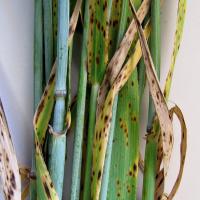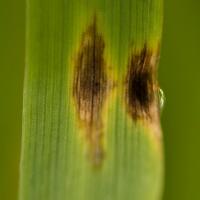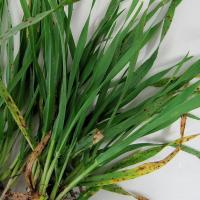Diagnosing spot type net blotch
Spot-type net blotch is a stubble-borne fungal foliar disease occurring more frequently in the medium and high rainfall areas of the West Australian (WA) wheatbelt. Up to 44% yield loss under severe disease pressure and increased screenings have been recorded. Spot-type net blotch differs from spot blotch, a leaf disease occurring in the eastern states of Australia. Spot blotch has not been identified in WA.
What to look for
- Blotched, yellowing and dead leaves generally evenly distributed across the paddock.
Paddock
- Oval dark brown spots with yellow edges that occur first and more severely on older leaves.
- As spots age they elongate and join together causing blotch symptoms.
- With severe infection, the leaves turn yellow and die back from the tips.
- Symptoms can vary with varietal resistance.
- Shrivelled grain with severe infection.
Plant
What else could it be
| Condition | Similarities | Differences |
|---|---|---|
| Diagnosing net type net blotch | Brown spots. Similarities only occur during the early stages of infection | Spots expand into net-pattern lesions (Net-type net blotch). |
| Diagnosing physiological leaf spot in barley | Brown spots. Similarities only occur during the early stages of infection | Spot-type net blotch lesions develop into more oval shaped lesions that can also affect the leaf sheath. |
| Diagnosing boron toxicity in barley | Brown spots. Similarities only occur during the early stages of infection | Spot-type net blotch lesions develop into more oval shaped lesions that can also affect the leaf sheath. |
Where did it come from?

Green bridge
- The fungus is carried from season to season on infected barley and wild grass residues, regrowth barley or infected seed that acts as an initial source of infection.
- Early in the season, wind-blown spores spread over long distances to infect early unprotected sown crops.
- Spores released from initial infection are spread from leaf to leaf by rain splash, so serious disease is seen when there is frequent rainfall and a dense canopy that retains moisture on the leaves for a longer period of time. Drying spring conditions slow the cycle of infection.
- Potassium deficient crops are more susceptible to leaf disease.
Management strategies

Resistant varieties

Stubble management

Spraying fungicide

Grass weed control
- Avoid cropping barley on barley in medium to high rainfall areas.
- Avoid growing highly susceptible varieties.
- Reduce stubble residue carry-over as much as possible.
- Foliar fungicides containing triazole and strobilurin are effective in spot-type net blotch control.
- Treat for potassium deficiency if economically viable to do so.
- Control barley grass.
See also
Where to go for expert help
Page last updated: Monday, 9 November 2015 - 2:37pm





